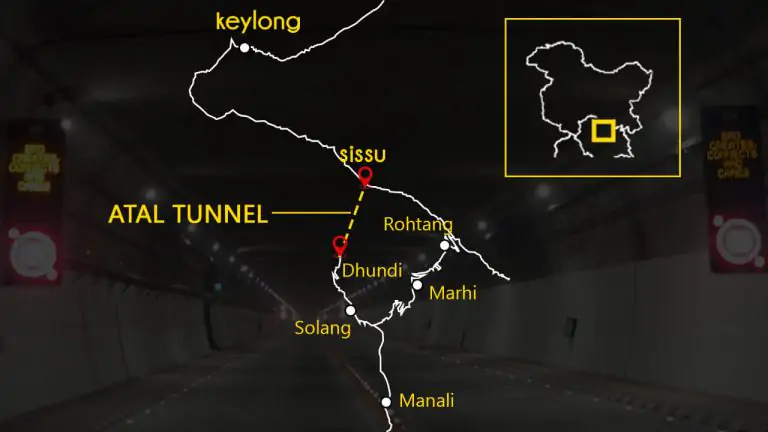The Atal Tunnel, also known as the Rohtang Tunnel, is a highway tunnel constructed under the Rohtang Pass in the eastern Pir Panjal range of the Himalayas on the National Highway 3 in Himachal Pradesh, India. Named after former Prime Minister of India, Atal Bihari Vajpayee, it holds the record for being the highest highway single-tube tunnel above 10,000 feet (3,048 m) in the world.
Key Features of the Atal Tunnel
| Feature | Description |
| Length | 9.02 km (5.6 mi) |
| Shape (cross-section) | Horseshoe |
| Finished width | 10.00 m (32.8 ft) at road level (8m pavement and 1m footpath on both sides) |
| Geology of tunnelling media | Uniformly dipping alternate sequence of quartzites, quartzitic schists, and quartz-diorite-schist with thin bands |
| General altitude | 3,000–3,100 m or 9,840–10,170 ft |
| Construction technique | Drill and blast with NATM |
| Support system | Fibre-reinforced concrete (100–300mm or 0–10 inch thick) combined with rock bolt (26.50mm dia, 5,000–9,000mm or 200–350 inch long) |
| Tunnel ventilation | Semi-transverse system of ventilation |
| Emergency tunnel | A 2.25 m high and 3.6 m wide emergency tunnel is integrated into the tunnel cross-section beneath the main carriageway |
| Project Cost | Approximately ₹3,200 crore |
Impact on Travel
The Atal Tunnel significantly reduces the travel time and overall distance between Manali and Keylong on the way to Leh. The route, which previously went through Gramphu, was 116 km (72.1 mi) long and took 5 to 6 hours in good conditions. With the new route via the tunnel, the total distance travelled is brought down to 71 km (44.1 mi) which can be covered in about 2 hours, a reduction of around 3 to 4 hours when compared to the earlier route.

Comparison with Other Tunnels
The 9.02 km (5.6 mi) long Atal Tunnel is presently the world’s longest single-tube highway tunnel at an altitude above 3,000 m(10,000 ft). There are some railway tunnels like the 32.645 km long New Guaijiao Railroad Tunnel at 3,300 meters above sea level in China. Higher but shorter tunnels in China include the 7.1-kilometre Que’ershan Tunnel at 4378 meters and the 5.7-kilometre Milashan Tunnel at 4774 meters.
Challenges Faced During Construction
The most challenging task was to continue the excavation during heavy snowfall in winter. Excavation for tunnelling was done from both ends. However, as Rohtang Pass closes during the winter, the north portal was not accessible during winter and the excavation was being done only from the south portal in winter.
Conclusion
The Atal Tunnel is a testament to human ingenuity and perseverance. Despite the numerous challenges faced during its construction, it stands today as a marvel of engineering and a boon for travelers and commuters alike.
Construction projects, especially large-scale ones like the Atal Tunnel, involve intricate planning, coordination, and communication. Apps like Field360 simplify these processes by centralizing data, facilitating real-time collaboration, and ensuring everyone is on the same page. From tracking progress to allocating resources efficiently, project management apps play a crucial role in successful construction endeavors.
Frequently Asked Questions
– The Atal Tunnel spans a length of 9.02 kilometers, making it the longest highway single-tube tunnel above 10,000 feet in the world.
– Elevation: It sits at an elevation of 3,100 meters (10,171 feet), while the Rohtang Pass is at 3,978 meters (13,051 feet).
– Year-round Connectivity: The tunnel ensures year-round connectivity to Ladakh, linking it to Manali and Chandigarh without relying on the snow-covered Rohtang Pass in winter.–
– Strategic Advantage: It benefits the armed forces by providing uninterrupted troop and supply movements to border areas.
The tunnel is equipped with:
– Semi-transverse ventilation
– SCADA-controlled firefighting systems
– Monitoring systems for lighting
– Emergency telephone connections every 150 meters
– Fire hydrants every 60 meters
– CCTV cameras every 250 meters
– Emergency exits every 500 meters
– Boost to Tourism: The tunnel improves livelihoods for residents in Lahaul Valley and Ladakh, enhancing tourism prospects.
– Farmers and Markets: Easier access to Delhi and other markets benefits farmers, ensuring crops like peas and potatoes reach markets without spoiling.
– Overall Connectivity: It significantly shortens travel time between Manali and Leh, benefiting both locals and tourists.












